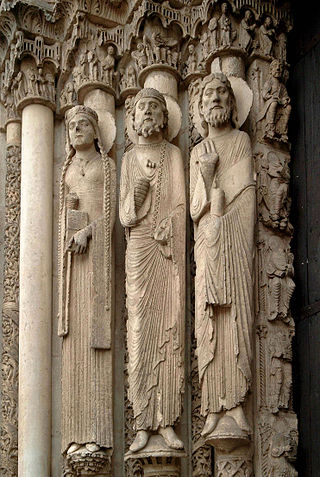
Gothic art was a style of medieval art that developed in Northern France out of Romanesque art in the 12th century AD, led by the concurrent development of Gothic architecture. It spread to all of Western Europe, and much of Northern, Southern and Central Europe, never quite effacing more classical styles in Italy. In the late 14th century, the sophisticated court style of International Gothic developed, which continued to evolve until the late 15th century. In many areas, especially Germany, Late Gothic art continued well into the 16th century, before being subsumed into Renaissance art. Primary media in the Gothic period included sculpture, panel painting, stained glass, fresco and illuminated manuscripts. The easily recognizable shifts in architecture from Romanesque to Gothic, and Gothic to Renaissance styles, are typically used to define the periods in art in all media, although in many ways figurative art developed at a different pace.

Romanesque art is the art of Europe from approximately 1000 AD to the rise of the Gothic style in the 12th century, or later depending on region. The preceding period is known as the Pre-Romanesque period. The term was invented by 19th-century art historians, especially for Romanesque architecture, which retained many basic features of Roman architectural style – most notably round-headed arches, but also barrel vaults, apses, and acanthus-leaf decoration – but had also developed many very different characteristics. In Southern France, Spain, and Italy there was an architectural continuity with the Late Antique, but the Romanesque style was the first style to spread across the whole of Catholic Europe, from Sicily to Scandinavia. Romanesque art was also greatly influenced by Byzantine art, especially in painting, and by the anti-classical energy of the decoration of the Insular art of the British Isles. From these elements was forged a highly innovative and coherent style.

Crusader art or the art of the Crusades, meaning primarily the art produced in Middle Eastern areas under Crusader control, spanned two artistic periods in Europe, the Romanesque and the Gothic, but in the Crusader kingdoms of the Levant the Gothic style barely appeared. The military crusaders themselves were mostly interested in artistic and development matters, or sophisticated in their taste, and much of their art was destroyed in the loss of their kingdoms so that only a few pieces survive today. Probably their most notable and influential artistic achievement was the Crusader castles, many of which achieve a stark, massive beauty. They developed the Byzantine methods of city-fortification for stand-alone castles far larger than any constructed before, either locally or in Europe.

Armenian illuminated manuscripts, form an Armenian tradition of formally prepared documents where the text is often supplemented with flourishes such as borders and miniature illustrations. They are related to other forms of Medieval Armenian art, Persian miniatures, and to Byzantine illuminated manuscripts. The earliest surviving examples date back to the Golden Age of Armenian art and literature in the 5th century. Armenian illuminated manuscripts embody Armenian culture; they illustrate its spiritual and cultural values.
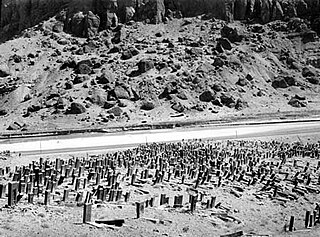
The Armenian cemetery in Julfa was a cemetery near the town of Julfa, in the Nakhchivan exclave of Azerbaijan that originally housed around 10,000 funerary monuments. The tombstones consisted mainly of thousands of khachkars—uniquely decorated cross-stones characteristic of medieval Christian Armenian art. The cemetery was still standing in the late 1990s, when the government of Azerbaijan began a systemic campaign to destroy the monuments.

Armenian architecture comprises architectural works with an aesthetic or historical connection to the Armenian people. It is difficult to situate this architectural style within precise geographical or chronological limits, but many of its monuments were created in the regions of historical Armenia, the Armenian Highlands. The greatest achievement of Armenian architecture is generally agreed to be its medieval churches and seventh century churches, though there are different opinions precisely in which respects.

Noratus cemetery, also spelled Noraduz, is a medieval cemetery with many early khachkars located in the village of Noratus, Gegharkunik Province near Gavar and Lake Sevan, 90 km north of Yerevan.

Tsitsernavank is a fifth-to-sixth century Armenian Apostolic monastery in the Lachin District of Azerbaijan. The monastery is within five kilometers of the border of Armenia's province of Syunik, in an area historically known as Kashataghk.

Karmravor, also known as the Church of Holy Mother of God is a 7th-century Armenian Apostolic church in the town of Ashtarak in the Aragatsotn Province.
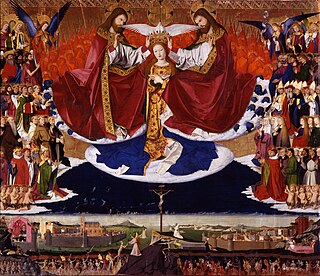
Catholic art is art produced by or for members of the Catholic Church. This includes visual art (iconography), sculpture, decorative arts, applied arts, and architecture. In a broader sense, Catholic music and other art may be included as well. Expressions of art may or may not attempt to illustrate, supplement and portray in tangible form Catholic teaching. Catholic art has played a leading role in the history and development of Western art since at least the 4th century. The principal subject matter of Catholic art has been the life and times of Jesus Christ, along with people associated with him, including his disciples, the saints, and motifs from the Catholic Bible.

Sirarpie Der Nersessian was an Armenian art historian, who specialized in Armenian and Byzantine studies. Der Nersessian was a renowned academic and a pioneer in Armenian art history. She taught at several institutions in the United States, including Wellesley College in Massachusetts and as Henri Focillon Professor of Art and Archaeology at Harvard University. She was a senior fellow at Dumbarton Oaks, its deputy director from 1954–55 and 1961–62, and a member of its Board of Scholars. Der Nersessian was also a member of several international institutions such as the British Academy (1975), the Académie des Inscriptions et Belles-Lettres (1978), and the Armenian Academy of Sciences (1966).

Levon Chookaszian is an Armenian art historian and the UNESCO Chair of Armenian Art History. He is also currently the Head of Chair of History and Theory of Armenian Art at Yerevan State University. Professor Chookaszian has delivered numerous lectures, particularly on medieval Armenian art, at universities in the former Soviet Union, Europe, and the United States and taught courses on Armenian art at UCLA.
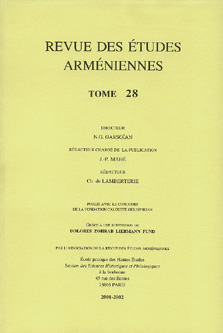
Revue des Études Arméniennes is a peer-reviewed academic journal that publishes articles relating to Classical and medieval Armenian history, art history, philology, linguistics, and literature. The Revue was established in 1920 at the initiative of French scholars Frédéric Macler and Antoine Meillet. Meillet himself wrote many of the articles during the formative years of the journal (1920–1933), which typically covered Armenian history, grammar, and folk tales, including the modern period. The Revue was not published from 1934 to 1963.
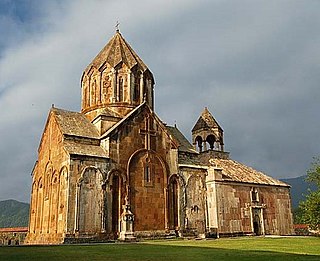
Culture of Artsakh includes artifacts of tangible and intangible culture that has been historically associated with Artsakh in the Southern Caucasus, controlled by Azerbaijan and the breakaway Republic of Artsakh. These include monuments of religious and civil architecture, memorial and defense structures, and various forms of art.

The Cathedral of Mren is a 7th-century Armenian church in an abandoned medieval town site called Mren. It is located in the Kars region of Turkey, near the border with Armenia, about 1.5 km west of the Akhurian River.

The Church of Saint Sarkis in Tekor was a 5th-century Armenian church built in historical Armenia. It was located facing the town of Digor in the Kars Province of Turkey, about 16 kilometers west of the Armenian border. Tekor was a three aisled basilica with a dome. It was severely damaged by earthquakes in 1912 and 1936, and later damaged by vandalism. Now only the lower parts of the rubble and concrete core of the walls remain, the facing stone apparently removed to build the town hall in the 1960s. The inscription dating the building to the 480s was the oldest known writing in the Armenian language.

Sanahin Monastery is an Armenian monastery founded in the 10th century in Sanahin in the Lori Province of Armenia.
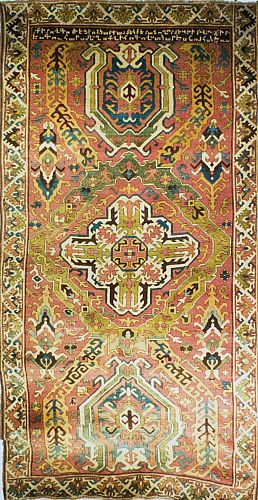
The term Armenian carpet designates, but is not limited to, tufted rugs or knotted carpets woven in Armenia or by Armenians from pre-Christian times to the present. It also includes a number of flat woven textiles. The term covers a large variety of types and sub-varieties. Due to their intrinsic fragility, almost nothing survives—neither carpets nor fragments—from antiquity until the late medieval period.

The Armenian eternity sign or Arevakhach is an ancient Armenian national symbol and a symbol of the national identity of the Armenian people. It is one of the most common symbols in Armenian architecture, carved on khachkars and on walls of churches.
Armenian church architecture is the architectural style of the Armenian church buildings created since the Apostolic era of Christianity in the Armenian Highland during the 1st century. It was developed over the last 1900 years. According to professor Dickran Kouymjian, the unique national style of Armenian church architecture came into being by the late 6th or early 7th century, probably becoming the first national style in Christian architecture, long before the Byzantine, Romanesque and Gothic or the less known Ethiopian, Scandinavian and Slavic styles were concretely formed.


























